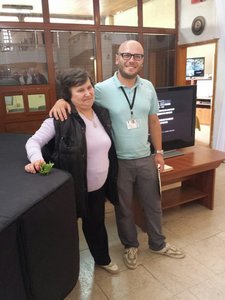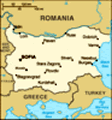Advertisement

 Stefan and mama
Stefan and mama
Taken by Connie Korn.Geo: 42.6622, 27.7075
Our morning started with a drive through the Balkan Range. There are fields and copses and acres of sunflowers, all with their heads bowed, and then suddenly a small, depressing village where dogs guard junk yards and other places that you can't imagine anyone even wanting to break into. The houses are in disrepair or abandoned altogether, and small public squares are overgrown with weeds, almost as if any civic pride ended when Communism did. On the other hand, the countryside is rather lovely, though nothing out of the ordinary.
We passed through the Valley of the Thracian Kings, a/k/a The Valley of Roses. Kazanluk, our destination, is smack in the middle of this valley. Roses are a big deal in Bulgaria, as 60 percent of the world's rose products come from here. The harvest is over 40 days from May to June, and there are three varieties grown. A skilled picker can pick 50 kilos of rose petals a day, and it takes 4,000 kilos of petals to make one kilo of rose oil. Rose oil is mainly used in perfumes and pharmaceuticals, and rose water is used in cosmetics, pies, and creams.
The rose industry is so important
to Kazanluk that they have a rose festival (and have had for over 100 years) and choose a Queen of the Roses. There are two criteria for being queen: 1) she must be from Kazanluk, and 2) she must be a senior in high school.
In addition to roses, lavender is also grown in the region, partly as a way to keep the distilleries open longer. Stefan admitted that French lavender is better, but Aveda buys both rose and lavender oil from Bulgaria. Chanel and Burberry also buy Bulgarian rose oil for their products.
The Japanese are enthusiastic about rose oil because in the 1980s, the Japanese Emperor visited and was introduced to rose oil and Bulgarian yogurt. He liked them both; ergo, the Japanese like them both too, and there has been a boom in Japanese tourists in Bulgaria since the '80s. Some liked Bulgaria so much that they decided to stay, partly for the weather and partly for the rakia. In fact, one Bulgarian landlord complained that his Japanese tenants not only didn't pay their rent, they also drank all of his rakia!
A recent rose-related craze among Japanese women is to take rose oil pills. Then if they sweat,
they smell of roses. Stefan says he tried this, and it worked.
The area also has the largest Kalashnikov factory in Bulgaria (though it doesn't pay any patent royalties to the Russians). This means that Kazanluk can be called, yes, the town of Guns & Roses. Between the roses and the guns, unemployment in the area is only four percent.
So our first stop in Kazanluk was at the Iskra Museum and Art Gallery. Stefan's mom used to work at the museum, and she was there to welcome us and say a few words. Stefan was a little embarrassed that his mom showed up, but he is quite clearly her little boy and he ran to her to give her a hug and kisses. She was a sweet, tiny little thing with a bit of palsy and even though she doesn't speak English, she could understand enough when Barb told her that we just love her son. She beamed.
Anyway, the museum had archaeological finds from Thracian tombs, including a gorgeous golden laurel wreath from around the 4th century BC. The circlet was far too big for an ordinary head, so it's speculated that it was meant to sit atop a helmet that
was found in the same tomb. The helmet has two small hooks on each side just above the ears, so archaeologists think the wreath attached to the hooks somehow.
After leaving mama, we drove two minutes to a park that contains a tomb of a 4th-century-BC Thracian ruler. The tomb is closed, but there is a replica museum a minute's walk away. Stefan's aunt works there, so he saw a lot of family today. Stefan himself began helping with archaeological digs in the area when he was seven or eight years old, and he was at the dig the day the above-mentioned helmet was found. The beehive-shaped tomb was small and cramped but contained an interesting ceiling fresco that has been interpreted as a wedding scene, a funeral scene, and a coronation scene. Stefan thinks it's a funeral scene because it's got chariot races, which are generally depicted on funerary art.
We had our lunch at a Russian church a little way outside of town in Shipka. We have now seen 100% of the Russian churches in the country. This particular church is here because there were Russian troops here at one time fighting a war against the Turks. It's huge compared

 Stork's nest
Stork's nest
Terrible photo taken through a dirty bus window. The fuzzy thing on top of the chimney is a stork's nest. No evidence of the stork.to the little Russian church in Sofia. It has beautiful golden onion domes and pretty painted walls. I didn't go in because we only had 30 minutes to eat our lunch and use the bathrooms. Lunch was brought by a family from the town of Shipka, and we had chosen a couple of days ago what we wanted. My sandwich, which was enormous, was chicken with peppers, pickles, and french fries (inside the sandwich), and there were grapes, Fanta, and a chocolate dessert thing. Very good and very filling. We had to eat in the bus because it suddenly started to pour.
We visited another tomb, this time original. It was at the top of a small hill and slightly bigger than the first tomb we saw. This one had a column right in the middle of the corridor, and a larger but less decorative burial chamber. I'm still not quite sure who was buried there, but it was a man and his "favorite" wife, who would have been ritually killed after his death so that they could be together.
We arrived in Nesebar (pronounced neh-SEB-r) on the Black Sea at 5:45. We went for a walk around the neighborhood and to
the town gates. Old Town Nesebar (where we are) sits on a small peninsula that is connected to the new town by a man-made isthmus. It takes 20 minutes to walk from the gates to the other end of the peninsula, so it's pretty much impossible to get lost (but watch me manage it tomorrow). Stefan pointed out some good restaurants, showed us a church we'll be visiting tomorrow, and warned us against changing money in this town. We also watched a Pomeranian and a small Yorkie (redundant?) play-fight.
Dinner was at our hotel, the Royal Palace. As a novelty, we started with shopska salad. Then we had vegetable soup, followed by freshly caught mackerel. Part of the reason I chose fish when Stefan passed around a list of choices the other day was because (a) the other option was zucchini with yogurt sauce, and (b) someone pointed out that it wasn't often you might get to eat fish from the Black Sea. Unfortunately, I can't manage fish if it's not filleted. All that skin and the tail … this one didn't have its head, at least. Discovered that mackerel is about as bland as you can get, and it's really bony too. Dessert was three plums and a peach (which is what I plan to call my next novel).
It's nearly 10:30 now, and I'd really like to read my book. But the idea of keeping my eyes open for another ten minutes seems utterly impossible.
Advertisement
Tot: 0.068s; Tpl: 0.014s; cc: 7; qc: 24; dbt: 0.0434s; 1; m:domysql w:travelblog (10.17.0.13); sld: 1;
; mem: 1.1mb








Mary
non-member comment
I am placing odds on whether you will ever eat another shop ska salad after the tour. Alternative title for your next book: Holy Mackerel or I'll Have the Shopska Salad.